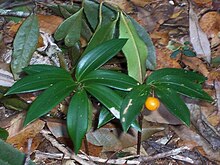
Guaiacum, sometimes spelled Guajacum, is a genus of flowering plants in the caltrop family Zygophyllaceae. It contains five species of slow-growing shrubs and trees, reaching a height of approximately 20 m (66 ft) but usually less than half of that. All are native to subtropical and tropical regions of the Americas and are commonly known as lignum-vitae, guayacán (Spanish), or gaïac (French). The genus name originated in Taíno, the language spoken by the native Taínos of the Bahamas; it was adopted into English in 1533, the first word in that language of American origin.

Ampelopsis, commonly known as peppervine or porcelainberry, is a genus of climbing shrubs, in the grape family Vitaceae. The name is derived from the Ancient Greek: ἅμπελος (ampelos), which means "vine". The genus was named in 1803. It is disjunctly distributed in eastern Asia and eastern North America extending to Mexico. Ampelopsis is primarily found in mountainous regions in temperate zones with some species in montane forests at mid-altitudes in subtropical to tropical regions. Ampelopsis glandulosa is a popular garden plant and an invasive weed.

A botanical name is a formal scientific name conforming to the International Code of Nomenclature for algae, fungi, and plants (ICN) and, if it concerns a plant cultigen, the additional cultivar or Group epithets must conform to the International Code of Nomenclature for Cultivated Plants (ICNCP). The code of nomenclature covers "all organisms traditionally treated as algae, fungi, or plants, whether fossil or non-fossil, including blue-green algae (Cyanobacteria), chytrids, oomycetes, slime moulds and photosynthetic protists with their taxonomically related non-photosynthetic groups ."

Cenchrus is a widespread genus of plants in the grass family. Its species are native to many countries in Asia, Africa, Australia, the Americas, and various oceanic islands.
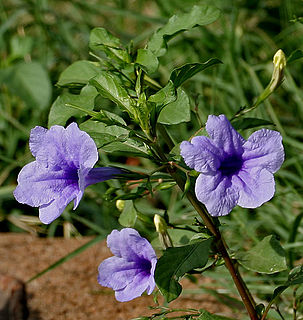
Ruellia is a genus of flowering plants commonly known as ruellias or wild petunias. They are not closely related to petunias (Petunia) although both genera belong to the same euasterid clade. The genus was named in honor of Jean Ruelle, herbalist and physician to Francis I of France and translator of several works of Dioscorides.
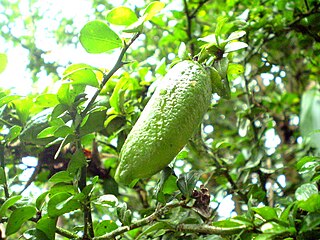
Citrus australasica, the Australian finger lime or caviar lime, is a thorny understorey shrub or small tree of lowland subtropical rainforest and rainforest in the coastal border region of Queensland and New South Wales, Australia.

Vachellia nilotica is a flowering plant tree in the family Fabaceae. It is native to Africa, the Middle East and the Indian subcontinent. It is also a Weed of National Significance in Australia as well as a Federal Noxious Weed in the United States.

Santalum album, or Indian sandalwood, is a small tropical tree, and the traditional source of sandalwood oil. It is native to southern India and Southeast Asia. It is considered sacred in some religions, and some cultures place great significance on its fragrant and medicinal qualities. However, the high value of the species has caused over-exploitation, to the point where the wild population is vulnerable to extinction. Indian sandalwood still commands high prices for its essential oil owing to its high alpha santalol content, but due to lack of sizable trees it is no longer used for fine woodworking as before. The plant is long-lived, but harvest is only viable after many years.

Canavalia is a genus of flowering plants in the legume family (Fabaceae) and comprises approximately 48 to 50 species of tropical vines. Members of the genus are commonly known as jack-beans. The species of Canavalia endemic to the Hawaiian Islands were named ʻāwikiwiki by the Native Hawaiians. The name translates to "the very quick one" and comes from the Hawaiian word for "fast" that has also been appropriated into the name "Wikipedia". The genus name is derived from the Malabar word for the species, kavavali, which means "forest climber."

Buchanania is a genus of plants in the family Anacardiaceae and subfamily Anacardioideae.
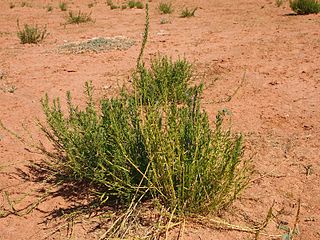
Stemodia is a genus of flowering plants in the family Plantaginaceae. The genus comprises approximately 40 species of annual and perennial herbs and shrubs which are distributed throughout temperate and tropical regions of Asia, Africa, Australia and the Americas. This genus is sometimes placed in the families Scrophulariaceae or Gratiolaceae. The generic name is derived from the Latin word stemodiacra, which means "stamens with two tips." Twintip is a common name for several species.

Stackhousia is a genus of annual and perennial plants in the family Celastraceae that are native to Australia, New Zealand, Malesia and Micronesia. The genus was first described by James Edward Smith in Transactions of the Linnean Society of London in 1798.

Scleranthus, the knawels, are a genus of herbaceous plants in the family Caryophyllaceae.

Tripladenia is a monotypic genus of plants in the family Colchicaceae. The sole species is Tripladenia cunninghamii which is native to New South Wales and Queensland in Australia.
Beilschmiedia bancroftii is a tree species in the family Lauraceae. It is native to Queensland in Australia. Common names include yellow walnut, yellow nut and canary ash.
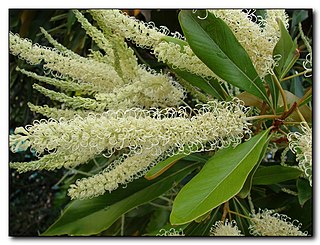
Grevillea baileyana, commonly known as white oak, is a tree of the family Proteaceae that is native to the rainforests of north-east Queensland in Australia and Papua New Guinea.

Embelia is a genus of climbing shrubs once placed in the family Myrsinaceae, which is now included in the Primulaceae. There are about 130 species which occur in tropical and subtropical areas across a wide range including Africa and Madagascar and from eastern Asia to the Pacific Islands as well as Australia including:

Drymophila moorei, the orange berry, occurs naturally from the Manning River in northern New South Wales to Queensland. The habit is as a herb, occurring at the rainforest floor, usually at high altitudes. Easily identified when in fruit.
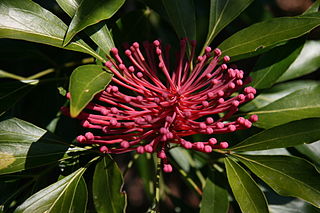
Alloxylon pinnatum, known as Dorrigo waratah, is a tree of the family Proteaceae found in warm-temperate rainforest of south-east Queensland and northern New South Wales in eastern Australia. It has shiny green leaves that are either pinnate (lobed) and up to 30 cm (12 in) long, or lanceolate (spear-shaped) and up to 15 cm (5.9 in) long. The prominent pinkish-red flower heads, known as inflorescences, appear in spring and summer; these are made up of 50 to 140 individual flowers arranged in corymb or raceme. These are followed by rectangular woody seed pods, which bear two rows of winged seeds.

Drymophila cyanocarpa, also known as turquoise berry or native Solomon's seal, is a species of flowering plant in the family Alstroemeriaceae. It is a herbaceous perennial, growing up to 60 cm in height. Leaves are 3 to 8 cm long and 5 to 15 mm wide. Pendant white, cream or light mauve flowers appear between November and January in the species' native range. These are followed by blue to purple ovoid berries that are between 5 and 10 mm long. It occurs in the Australian states of Tasmania, Victoria and New South Wales.
